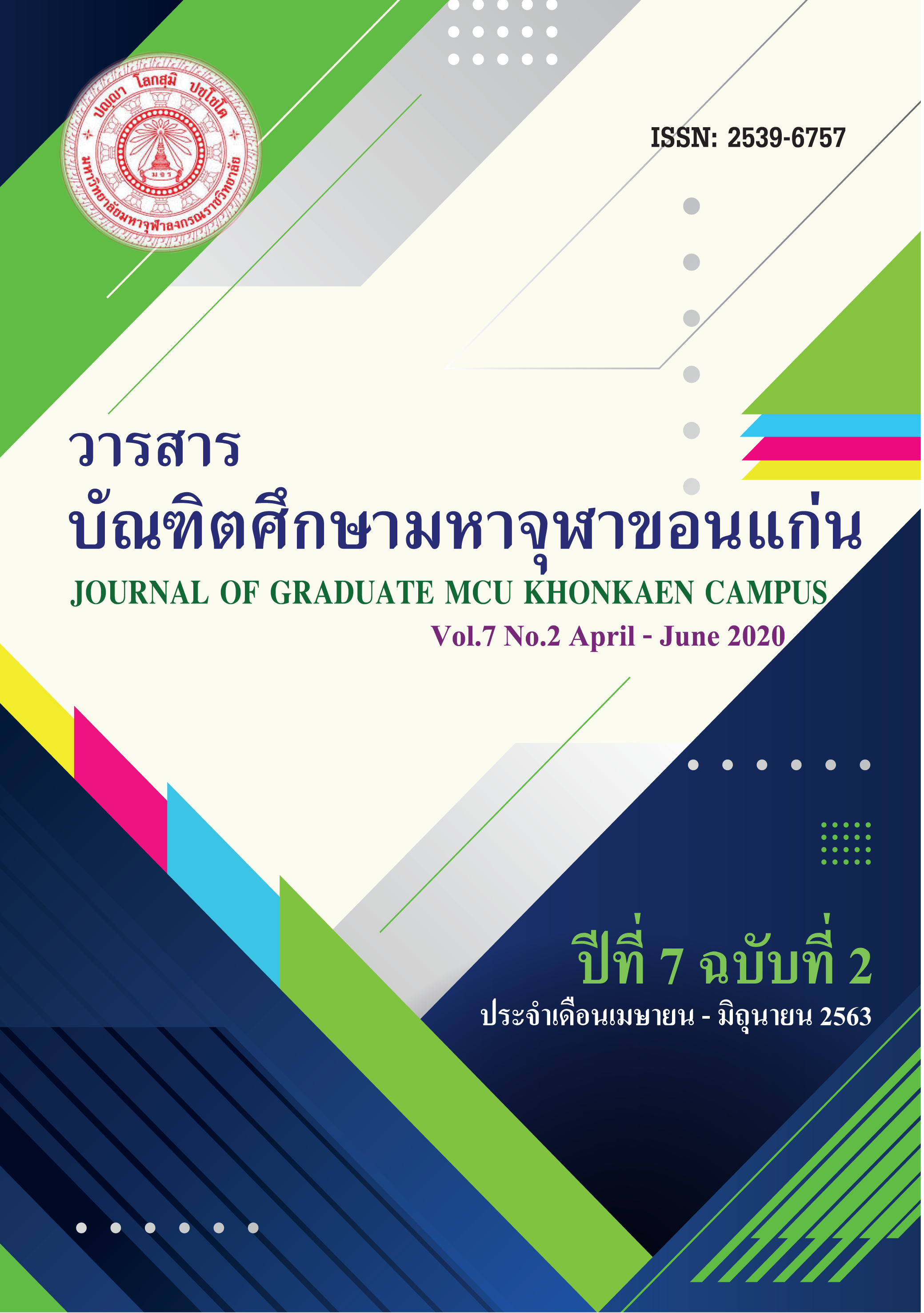THE FOREST : COMMUNITY IN THE NORTHEAST BY THE ECOLOGY OF THE BUDDHA
Main Article Content
Abstract
The purpose of this research: 1. To study the principles and ecological guidelines for community management of monks in the northeastern region, 2. To study the policy and mechanism of community forest management of the people sector and local government organization In the northeast region, 3. To strengthen the network of community forest management in the northeast region in accordance with Buddhist ecology. Conducting research using qualitative research methods the research areas of Maha Sarakham Province, Roi-Et Province and Kalasin Province.
The results of the research showed that.
- Ecology principles and guidelines in Buddhism doctrine are divided into 2 parts, which are dharma and discipline. Which shows the value of nature and environment which is the most important contribution to life is to be free from suffering. Natural forests are the 4 source of livelihoods. The monks are spiritual community leaders. Able to apply social doctrines and practices to help drive conservation and management of community forests to achieve the goal.
- Policy on community forest management of the people and local administrative organizations And the concept of community forest conservation and community forest management model of monks in the northeast region, found that is Forest Restoration, Conservation forest, Anti-Injustice, Awareness and development promotion.
- Strengthening the network of community forest management in the northeastern region in accordance with Buddhist ecology Methods or guidelines include Establishment of a community forest committee Which is a representative of the villagers Selected from people who are selfless and knowledgeable and interested in forest conservation Responsible for determining policies or management guidelines For the benefit and worthiness and sustainability Set rules for mutual use. And strict compliance with those rules.
Article Details
How to Cite
Aranyavat, S., Akutarasatatikoon (Wongtham), P., & Pariyatworamathee (Thipmanee), P. . (2020). THE FOREST : COMMUNITY IN THE NORTHEAST BY THE ECOLOGY OF THE BUDDHA. Journal of Graduate MCU KhonKaen Campus, 7(2), 230–246. retrieved from https://so02.tci-thaijo.org/index.php/jg-mcukk/article/view/241928
Section
Research Article
References
กอบกุล รายะนาคร อ้างถึงใน อานันท์ กาญจนพันธุ์ และคณะ, “พลวัตของชุมชนในการจัดการทรัพยากร กระบวนทัศน์และนโยบาย”, รายงานการวิจัย, กรุงเทพมหานคร : สำนักงานกองทุนสนับสนุนการวิจัย, 2543.
โกมล แพรกทอง. ป่าชุมชนในประเทศไทย: แนวความคิดป่าชุมชน. พิมพ์ครั้งที่ 3. กรุงเทพฯ: โรงพิมพ์การศาสนากรมการศาสนา, 2537.
เกรียงศักดิ์ เจริญวงศ์ศักดิ์. การจัดการเครือข่ายการ: กลยุทธ์สำคัญสู่ความสำเร็จทางการปฎิรูปการศึกษา. กรุงเทพฯ: ซัสเซสมีเดีย, 2543.
จิรากรณ์ คชเสนี. มนุษย์กับสิ่งแวดล้อม. กรุงเทพมหนคร: โรงพิมพ์จุฬาลงกรณ์มหาวิทยาลัย,2549.
ฉลาดชาย รมิตานนท์, ป่าไม้สังคมกับการพัฒนาชนบท, กรุงเทพมหานคร : สมาคมสังคมศาสตร์ แห่งประเทศไทย, 2528.
สุรีรัตน์ กฤษณะรังสรรค์, การจัดการป่าขององค์กรชุมชนในเขตอุทยานแห่งชาติ ศึกษากรณี : หมู่บ้านก้อทุ่ง ตำบลก้อ อำเภอลี้ จังหวัดลำพูน, กรุงเทพมหานคร : คณะสังคมสงเคราะห์ศาสตร์ มหาวิทยาลัยธรรมศาสตร์, 2540
หน้า 28.
สัณฐิตา กาญจนพันธุ์, ความร่วมมือในการจัดการป่าระหว่างรัฐกับวัด : กรณีป่าชุมชนวัดพระธาตุดอยจอมแจ้ง อำเภอสะเก็ด จังหวัดเชียงใหม่, เชียงใหม่ : สถาบันวิจัยสังคม มหาวิทยาลัยเชียงใหม, 2543.
อานันท์ กาญจนพันธุ์ และมิ่งสรรพ์ ขาวสะอาด, วิวัฒนาการบุกเบิกที่ดินทำกินในเขตป่า : กรณีศึกษาภาคเหนือตอนบน, กรุงเทพมหานคร : สถาบันวิจัยเพื่อการพัฒนาประเทศไทย, 2538.
โกมล แพรกทอง. ป่าชุมชนในประเทศไทย: แนวความคิดป่าชุมชน. พิมพ์ครั้งที่ 3. กรุงเทพฯ: โรงพิมพ์การศาสนากรมการศาสนา, 2537.
เกรียงศักดิ์ เจริญวงศ์ศักดิ์. การจัดการเครือข่ายการ: กลยุทธ์สำคัญสู่ความสำเร็จทางการปฎิรูปการศึกษา. กรุงเทพฯ: ซัสเซสมีเดีย, 2543.
จิรากรณ์ คชเสนี. มนุษย์กับสิ่งแวดล้อม. กรุงเทพมหนคร: โรงพิมพ์จุฬาลงกรณ์มหาวิทยาลัย,2549.
ฉลาดชาย รมิตานนท์, ป่าไม้สังคมกับการพัฒนาชนบท, กรุงเทพมหานคร : สมาคมสังคมศาสตร์ แห่งประเทศไทย, 2528.
สุรีรัตน์ กฤษณะรังสรรค์, การจัดการป่าขององค์กรชุมชนในเขตอุทยานแห่งชาติ ศึกษากรณี : หมู่บ้านก้อทุ่ง ตำบลก้อ อำเภอลี้ จังหวัดลำพูน, กรุงเทพมหานคร : คณะสังคมสงเคราะห์ศาสตร์ มหาวิทยาลัยธรรมศาสตร์, 2540
หน้า 28.
สัณฐิตา กาญจนพันธุ์, ความร่วมมือในการจัดการป่าระหว่างรัฐกับวัด : กรณีป่าชุมชนวัดพระธาตุดอยจอมแจ้ง อำเภอสะเก็ด จังหวัดเชียงใหม่, เชียงใหม่ : สถาบันวิจัยสังคม มหาวิทยาลัยเชียงใหม, 2543.
อานันท์ กาญจนพันธุ์ และมิ่งสรรพ์ ขาวสะอาด, วิวัฒนาการบุกเบิกที่ดินทำกินในเขตป่า : กรณีศึกษาภาคเหนือตอนบน, กรุงเทพมหานคร : สถาบันวิจัยเพื่อการพัฒนาประเทศไทย, 2538.

